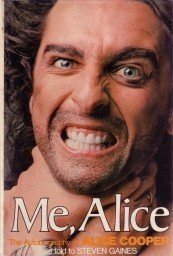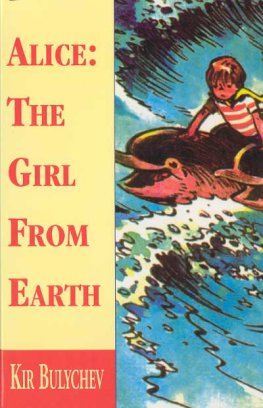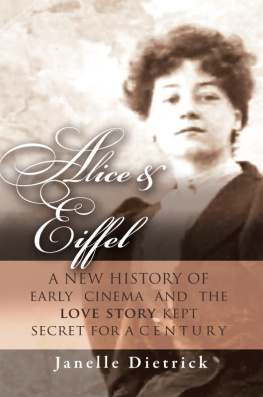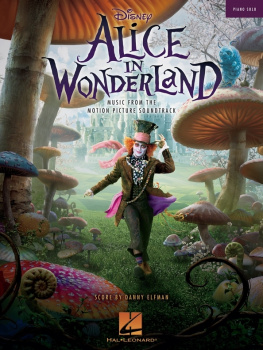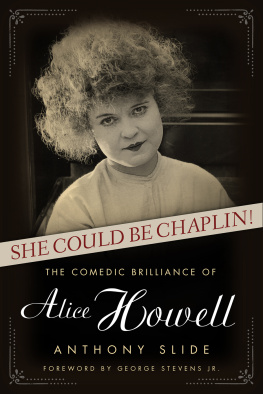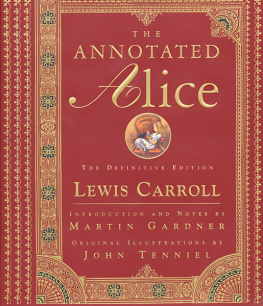Appendix A
A REMEMBRANCE
by Madame Olga Petrova
( The following was contained in an undated letter to Anthony Slide, written in the early seventies )
Alice Guy Blach was my first director in my first picture made under a contract for one film to be made by Popular Plays and Players. Mr. Lawrence Weber was its President. I believe the title was The Tigress. Mr. Aaron Hoffman was the author. This was in 1915.
I had met her and her husband, Mr. Herbert Blach, at Mr. Webers office. I liked them both but I was instinctively drawn to her. Had I been asked then WHY? The answer would have been simple, direct, WHY NOT?
Knowing nothing of the methods of motion picture making, including directors, the idea of their sex didnt occur to me. If it had I might have reasoned that Mr. Weber being an astute business man would not have risked losing the substantial profits he counted on me, a neophyte, if he had not recognized Madame Blach as a reliable, competent director, perfectly capable of protecting his interests. Anyhow, I asked if she might direct me, and was told she would be pleased to do so.
As I lived on Long Island, quite a distance from the studio at Fort Lee, New Jersey, which entailed ferrying my chauffeur, automobile and me across the Hudson River, 8:30 A.M. was fixed as my daily arrival there, subject to calls Mr. Lee Shubert might have for me under a contract with him.
A few weeks later at 8:30 A.M. precisely I reported at Fort Lee ready for initiation into the Magic, Mystery, ART and CRAFT of the moving picture business.
Madame Blach greeted me warmly. She introduced me to my co-workers of the day and to the cameraman by name. She showed me my dressing room. A vase of beautiful flowers welcomed me from the dressing table. She asked if I would like my lunch brought to me. She consulted me as to the menu, and so on. In later days she would occasionally meet with me there for a little cup of black after-lunch coffee, and interesting, pleasant conversation. The dresses I had brought were commented upon. I may say here that in those days wardrobe had to be furnished by the player, NOT the company. This was a considerable expense since one could not repeat any article of dress in any succeeding film.
These details having been attended to, Madame led me to the set. When the story had been sent to and read by me I had voiced surprise that no dialogue or action was included in it. Mr. Weber assured me that all this would be meticulously attended to later. It was. But in no way did it resemble anything I could have imagined it would.
Instead Madame vocally outlined what each episode was about with words and actionpantomime appropriate to the situation.
Of course, dialogue, pantomime, as practiced in the theatre, before audiences, individuals of which could see and hear from their various seats in the auditorium was one thing,but to portray them before the single, uncompromising eye of the camera lens was quite a different proposition. This discomfitted me.
I noticed immediately that my co-workers wore a make-up much darker than mine, almost a deep beige, whereas I wore the usual light Leichners 1-1/2. This discomfitted me still further, but as Madame Blach made no comment on it, neither did I.
I was shown the camera or cameras. I had been photographed in private studios by professional photographic artists but these cameras filled me with near terror. They appeared much taller, much bulkier than any I had seen. They seemed to resemble fearsome monsters from outer space. However...
Rehearsals started. In the first scene, as in all succeeding ones, Madame Blach outlined vocally what each episode was about with action, words appropriate to the situation. If the first or second rehearsal pleased her, even though a player might intentionally or not alter her instructions, as long as they didnt hurt the scene, even possibly improve it, she would allow this to pass. If not she would rehearse and rehearse until they did before calling camera. When she had cause to correct a player, she would do this courteously, and in my case, which was more than often, she might resort to her native tongue. This gentle gesture touched me deeply, softened any embarrassment I might feel.
After all scenes set for the day had been shot, the close-ups followed. These I found very difficult. The heat of the unguarded Klieg lights made ones eyes weep, ones skin burn, ones hair bristle. However they were part of ones obligations and so to be obeyed.
These concluded, Madame looked, and was, tired. But during rehearsals and shooting she never lost dignity nor poise. She wore a silken glove, but she would have been perfectly capable of using a mailed fist if she considered it necessary. This I never saw her do, either on the first day nor any other day while she directed me. She never bellowed through the megaphone as I was told many another director was wont to do. She obtained her results earning the respect and obedience of her artists. In the four succeeding pictures she never deviated from these methods.
Unfortunately I never met nor knew Madame, nor any other of my co-workers outside the studio. When work for the day was over I hurried back to husband, home and hearth as quickly as I couldand BED not long afterwards.
I suppose The Tigress pleased the public, and so Mr. Weber and Popular Plays and Players, since they offered me a contract covering a period of three years, albeit at a higher salary and again subject to plans Mr. Shubert might have for me. Madame Blach directed me in the first four under that aegis. They were, as I remember, The Heart of a Painted Woman, My Madonna, What Will People Say, and a story the name of which I dont remember, but was retitled as The Vampire for release. I am quite sure that if the last named had come to me under that title I could never have been presumptuous enough to attempt to interpret it. The realm of the Vampire character had been created for and royally queened over by Theda Bara, and I would no more have attempted to emulate her in such roles that I would those of an Ophelia either.
With the exception of What Will People Say, the play by Rupert Hughes, they were authored by Aaron Hoffman; though What Will People Say he adapted for the screen. Why Madame Blach didnt continue to direct me after these four I dont know, but I do know I missed her sorely. I only hope she found greener pastures. She probably did. Looking back again I retain for her the same reactions of deep affection and respect as I had for her so many years ago.
Appendix B
HERBERT BLACH: A BIOGRAPHICAL SKETCH
Although not a major figure in silent film history with none of his films discussed in any of the standard texts and few even surviving, Herbert Blach did direct a number of major personalities. He directed Alia Nazimova in The Brat (1919) and Stronger Than Death (1920), which he co-directed with Charles Bryant; he directed Ethel Barrymore in The Divorce (1919); and he directed Buster Keaton in The Saphead (1920). It was Herbert Blach who guided Mary Astor at the start of her career, directing the actress in two short subjects, The Beggar Maid (1921) and The Young Painter (1922). At the same time, it should be noted that much of Blachs career was spent in directing minor actresses such as Florence Reed, Emily Stevens and Catherine Calvert.
Herbert Blach-Bolton (to use his full name) was born in London on October 5,1882, of a French father and an English mother. He was educated in France, and because of his fluency in various languages he was hired by the London office of Gaumont to take care of its affairs in various Continental cities. He and Alice Guy were married in 1907, and that same year came to the United States, at which time the couple dropped Bolton from their name.


